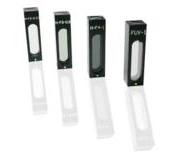Spectrophotometer calibration involves using a calibration standard or filter to verify the precision of the light source. The technique is vital to verify the effective functioning of the spectrophotometer and the measurements. The process is different for different instruments. Maintaining a calibration log gives information on who used the instrument last and when.
 NSG Spectrophotometer Calibration Kit
NSG Spectrophotometer Calibration Kit
Researchers at NSG Precision Cells after in-depth research on nano-desposition layering technology have created superior grade spectrophotometer calibration filters. The kits can calibrate multiple transmittance values and comply with NIST (National Institute of Standards and Technology) standards such as SRM 2031, 2034, and NIST930e.
The solid state calibration filters removed the need for liquid filters since they did not need to be re-calibrated or replaced. Solid neutral density filters are user-friendly and resistant to falls or rough use.
The solid state filters can deliver both photometric accuracy and stray light. Tests are concluded within five test factors and can help calibrate machines developed by Thermo Scientific, Beckman Coulter, Hitachi, Perkin Elmer, Hewlett Packard, Agilent, and Shimadzu.
The neutral density filters do not require distinctive filters to be zeroed. To calibrate the machine the neutral density filter should be placed within the spectrophotometer, the settings zeroed out, and run the instrument . The results should be compared to a calibration certificate given by the producer of calibration standards. If they comply with the tolerance array specifications stipulated by the manufacturer, then the instrument has been precisely calibrated. Before calibration, the instrument should be warmed up for about ten minutes, during which time calibration should not take place.